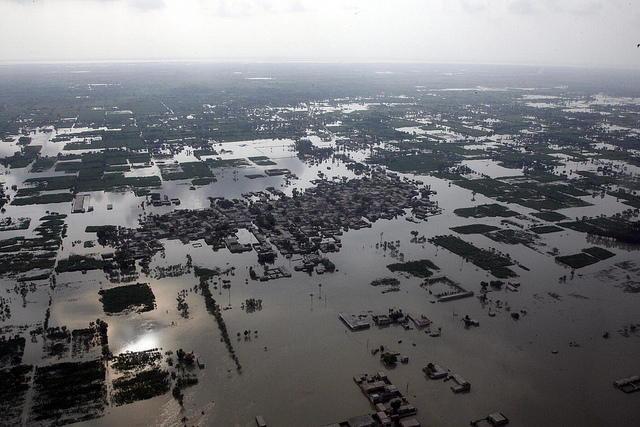On June 15, the Pakistan military launched an offensive against militants in North Waziristan, following the June 8 attack on Karachi’s airport, which led to an influx of over one million internally displaced persons from the war-ravaged region.
Since August, Imran Khan, leader of the opposition Pakistan Tehreek-e-Insaf party, has held sit-ins and protest rallies demanding the prime minister’s resignation.
At the same time, there has been little respite from sectarian violence and the number of polio cases has continued to grow much to the embarrassment of the government. The country has so far reported over 268 cases this year compared to 93 in 2013.
Torrential rains and floods
Torrential rains in the first week of September caused widespread flooding in the province of Punjab, Pakistan-administered Kashmir Khyber Pakhtunkhwa and Gilgit-Baltistan provinces.
The government’s National Disaster Management Authority (NDMA) put the death toll at 359, with over 1.7 million people affected and 2.35 million acres of land inundated. Punjab province declared a state of emergency with Jhang district hit the hardest. This time round, systems to cope with flooding were in place and earlier evacuation ahead of the floods saved many lives.
Early warning system
The Integrated Flood Assessment System, which was developed in 2012 with the help of Japan and UNESCO, worked well during the 2013 and 2014 monsoon floods in the Indus basin. Now the Pakistan Meteorological Department has proposed to integrate the missing component of snow and glacial melt into weather predictions. The PMD believes this will improve their ability to gauge the extent of floods and reduce the human and socio-economic impacts.
Drought in the Thar desert
As the water receded, the government’s attention shifted to the where at least 519 children died this year. The Thar desert is part of the Tharparkar district, which runs up to the border with India some 350 kilometres from Karachi.
….and then came Nilofar
By mid-October there were news reports that a severe tropical cyclonic storm, Nilofar, was forming over the Arabian Sea – the strongest since 2010 cyclone Phet – and would hit the shores of Sindh province on October 25.
It was expected to trigger rains and strong winds in lower parts of the province including Karachi. Fishermen were warned to avoid the sea and people were evacuated from some coastal areas. However, the raging storm weakened to a mere whimper when it hit the province on Oct 31.
Energy boost
By December, Pakistan had signed 19 agreements with China for projects worth billions of dollars to boost bilateral ties between the two countries. The majority of these deals were for energy projects, including coal-fired power plants (e.g. in Muzaffargarh, Qadirabad, Jamshoro), to provide the energy strapped country with over 16,000 megawatts of power. Pakistan’s daily power output is currently 11,000 megawatts.
China is also investing in the Quaid-e Azam Solar Park, near Bahawalpur in Punjab, which will generate 100 megawatts of electricity by the end of the year and add 1,000 megawatts to the national grid by 2016. Chinese companies and banks are also investing in a number of hydropower dams and windfarms.
Chinese investment in nuclear power has been particularly controversial. Beijing is providing Pakistan with five more nuclear power plants — three at Muzaffargarh in Punjab province and two to be built near the southern port city of Karachi aiming to generate 8,800 megawatts of nuclear power by 2030.
Two NGOs – the Pakistan Fisherfolk Forum and the Pakistan Institute of Labour Education and Research – have filed a case in the Sindh High Court against two Chinese nuclear reactors. They argued that the mandatory Environmental Impact Assessments and public hearings had not been conducted before work started on the projects. Scientists among the petitioners argue that the population within a 30-kilometre radius of the plants need to be relocated, while plant proponents claim only the population within the five-kilometre radius need to be moved.
2014 timeline:
January: At the ‘dome-laying ceremony’ of the Chashma-IV nuclear power plant, chairman of the Pakistan Atomic Energy Commission Dr Ansar Parvez promised the country will have seven nuclear plants by 2030 producing a total of 8,900 megawatts of electricity.
February: The Sindh Assembly unanimously passed the Sindh Environmental Protection Bill into law, the state’s first green law as environmental protection is devolved to a provincial level .
March: Construction of the Rawalpindi-Islamabad Metrobus, a 24 km bus rapid transit in the twin cities of Rawalpindi and Islamabad began.
July: A new World Bank report ‘Cleaning Pakistan’s Air’ claims the harm caused by air pollution in Pakistan’s urban areas is the worst in South Asia region.
August: A three-day meeting between India and Pakistan Indus Waters Commissioners, concluded with India agreeing to re-examine Pakistan’s objections over designs of Kishanganga dam and four other hydroelectric power projects on Jhelum and Chenab rivers.
September: Heavy monsoon rains and flash floods left over 250 people dead across Pakistan.
September: The Gender and Child Cell within Pakistan’s National Disaster Management Authority finalised guidelines to protect children who are at the risk of being separated from their families in emergencies.
November: Khyber Pakhtunkhwa cabinet lifted its decades long ban on cutting trees. In future forest management will be carried out along scientific lines according to government plans.
November: The federal government issued at least four permits to Gulf royal family members to export 43 internationally protected falcons facing threat of extinction in clear violation of national laws and international commitments related to nature conservation.

